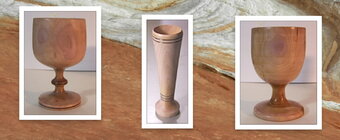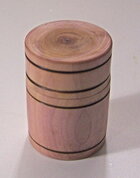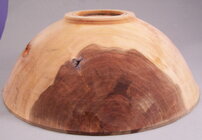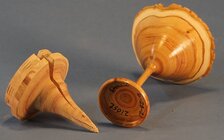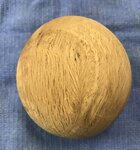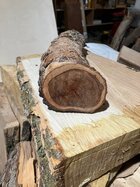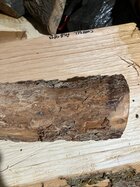This is a fairly specific topic, but, I have heard from multiple sources that Boxwood, Buxus sempervirens which is superb for intricate carving and turning, must cure/dry for 10 years before it can be touched or used. In Simpson, William T., ed. 1991. Dry Kiln Operator�s Manual from the USDA, harder woods take longer to dry, which checks out as Box is dense, so the ~1 year per inch rule is not going to be long enough. Boxwood is usually under 10 inches, so it would, after 10 years be dry? When people carve boxwood, they include the pith, and it is dry with no cracks. How? how is it that there is a reliable method of drying an entire round/log/branch with a pith without cracking? My intuition says that it is because the bark is on it, and it dries slowly.
Now, I don't have any boxwood, but I love Mountain Mahogany, Cercocarpus ledifolius. But, I cut a tree last year, and it air dried outside with the bark on, in the log form, and it split like Pac-Man (the smaller branches <4"). Now if it dried for another 9 years, would it not continue to crack, even without the endgrain exposed? Nearby, there are dead trees that are around 3" dia, and are weathered and when cut, has cracks throughout down to the pith.
All wood is different, and on Eric Meier's The Wood Database, Mountain Mahogany has less shrinkage, but a higher ratio of tangential to radial shrinkage than Boxwood. Is that why one can be dried with the pith and the other can't? does that mean that woods with a T/R ratio of ~1.5 and less can be dried without splitting? Even more confusing for me, Red alder, which grows where I live, has (according to Meier) about twice as much shrinkage than Mountain Mahogany, and a larger ratio than Box. Still, I have seen numerous instances of entire rounds 2-7" diameter without any checking even. Obviously I am looking to dry wood without any checking, without removing the pith (as smaller pieces such as boxes and carvings using a small branch cannot be made without removing the pith). There is no way that that is possible with Pacific Crabapple, which also grows where I live, but what allows Box and Alder to be dried without any curing-related qualms?
Now, I don't have any boxwood, but I love Mountain Mahogany, Cercocarpus ledifolius. But, I cut a tree last year, and it air dried outside with the bark on, in the log form, and it split like Pac-Man (the smaller branches <4"). Now if it dried for another 9 years, would it not continue to crack, even without the endgrain exposed? Nearby, there are dead trees that are around 3" dia, and are weathered and when cut, has cracks throughout down to the pith.
All wood is different, and on Eric Meier's The Wood Database, Mountain Mahogany has less shrinkage, but a higher ratio of tangential to radial shrinkage than Boxwood. Is that why one can be dried with the pith and the other can't? does that mean that woods with a T/R ratio of ~1.5 and less can be dried without splitting? Even more confusing for me, Red alder, which grows where I live, has (according to Meier) about twice as much shrinkage than Mountain Mahogany, and a larger ratio than Box. Still, I have seen numerous instances of entire rounds 2-7" diameter without any checking even. Obviously I am looking to dry wood without any checking, without removing the pith (as smaller pieces such as boxes and carvings using a small branch cannot be made without removing the pith). There is no way that that is possible with Pacific Crabapple, which also grows where I live, but what allows Box and Alder to be dried without any curing-related qualms?


